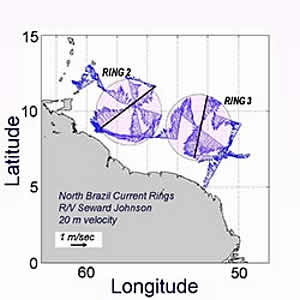
Researchers find that the North Brazil Current 'frisbees' are bigger and faster than previously thought
As the North Brazil Current (NBC) moves northward along the northeastern coast of Brazil, it draws water from the South Equatorial Current and the freshwater outflow from the Amazon River, providing a source for warm, nutrient-rich water. Just northwest of Brazil, part of the NBC banks a hard right and flows east along the equator. Occasionally, the turn is especially sharp and the current loops around, pinching off an independently- traveling parcel of warm water. This portion travels northwest with a clockwise rotation, moving through the ocean like a Frisbeeā¢ travels through air.
These current rings have been known to exist for decades, but knowledge of their basic properties such as size, speed, depth, and rotation velocity has been limited. Drawing on current profiles from both shipboard and stationary instruments, University of Miami researchers Guilherme Castel'o and Bill Johns describe the basic properties of ten rings sampled between 1998 and 2000. The authors find that the rings are best described as solid, clockwise-rotating parcels of water enclosed within a band of lower-speed water that tends to protect them from the surrounding environment.
Overall, this research has established that the NBC rings seem to be bigger, faster, and taller than previous observations suggested.
The study, titled "Sea surface structure of North Brazil Current rings derived from shipboard and moored acoustic Doppler current profiler observations" appears in the Journal of Geophysical Research ā" Oceans, a publication of the American Geophysical Union.
